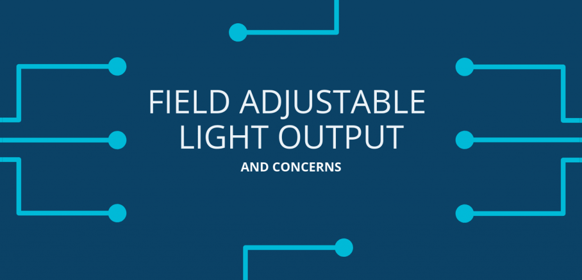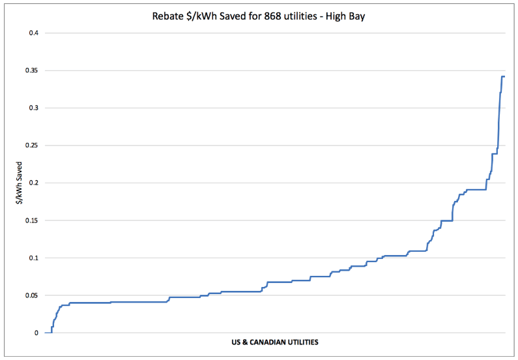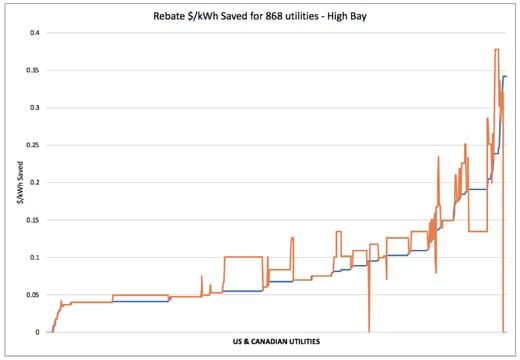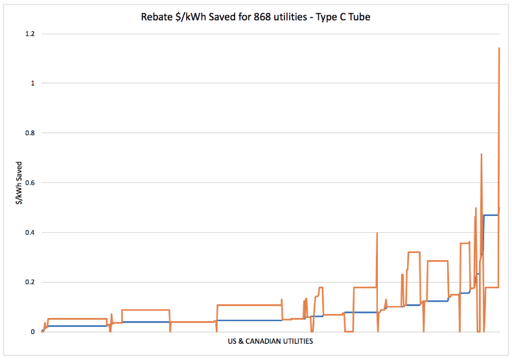
As part of the Design Lights Consortium’s® Technical Requirements V4.4 update, Field-Adjustable Products can now be listed on the SSL QPL. This policy update allows the QPL to keep up with innovations in this rapidly changing technology. Utility incentive programs response to this new policy has yet to be fully revealed, but early anecdotal discussions have given rise to some concerns, primarily regarding the following statement in the policy:
“Field-adjustable products, will be listed on the QPL at the full output setting, with the product performance characteristics from the LM-79 test: Light Output, Power Consumption, Efficacy, THD, Power Factor, CRI, CCT, Zonal Lumens, Spacing Criteria. Additionally, field adjustable products will list the reported default light output and default wattage.”
Default Approach Consequences
When evaluating a FAO product, the default behavior of the utility rebate program is to assume the highest possible wattage and lumens to calculate energy savings and incentives. This is the most conservative approach. Since the device settings could be adjusted after installation or inspection, it is understandable why utilities would lean toward this approach. However, utilities are not typically looking to be conservative when determining their energy savings, they’re trying to be accurate.
Taking the most conservative approach is not going to generate the most accurate results and could have the following impacts:
- Significantly underestimating energy savings. Utilities have energy savings goals every year, by assuming the highest wattage for FAO products, they are almost guaranteed to be underestimating the energy savings.
- Distorting the value of the rebate. If it’s a kWh or kW based calculation, the energy savings will be understated and the customer will see a lower rebate based on the conservative approach.
- Inaccurately representing the relationship between rebate dollars and kWh savings. When evaluating the rebate program, utilities may believe they are overpaying for savings. This could lead to a utility lowering their rebates in future years if they are seeing that the kWh savings are not lining with the rebate dollars distributed.
To illustrate the impact, we created two scenarios to help better explain what is happening.
SCENARIO 1: Metal Halide High Bay Replacement
250w MH recommended replacement with 112w@12000 lm LED HighBay
Manufacturer creates FAO device that replaces 150w-400w MH.
Max wattage for 400w replacement is 146w @ 18000 lm
Impacts
- For 250W scenario, 1 year kWh saved is reduced from 732 kWh to 596 kWh (19% less)
- Average increase in rebate $/kWh of $0.01. As high as $0.14/kWh for some utilities
Example Values in Pennsylvania
|
Utility |
State |
Rebate |
Rebate FAO |
| PECO Energy Co | PA | $75 | $42.50 |
| UGI Utilities, Inc | PA | $87.84 | $71.52 |
| Metropolitan Edison Co | PA | $36.60 | $29.80 |
| Pennsylvania Electric Co | PA | $36.60 | $29.80 |
| PPL Electric Utilities Corp | PA | $36.60 | $29.80 |
| Pennsylvania Power Co | PA | $36.60 | $29.80 |
| West Penn Power Company | PA | $36.60 | $29.80 |
| Duquesne Light Co | PA | $45 | $60 |
High-Bay Rebate $/kWh Saved - Original

High-Bay Rebate $/kWh Saved - FAO

SCENARIO 2 - Type C LED Tube Retrofit
28W existing fluorescent replaced with 12W LED Type C tube
Manufacturer FAO device ranges from 10-21 watts
Impacts
- Max wattage results in 1 year kWh saved is reduced from 64 kWh to 28 kWh (56% less)
- Average increase in rebate $/kWh of $0.03. As high as $0.64/kWh for one utility
Example Values in Pennsylvania
|
Utility |
State |
Rebate |
Rebate FA |
| UGI Utilities, Inc | PA | $7.68 | $3.36 |
| PPL Electric Utilities Corp | PA | $3.20 | $1.40 |
| Metropolitan Edison Co | PA | $3.20 | $1.40 |
| Pennsylvania Electric Co | PA | $3.20 | $1.40 |
| Pennsylvania Power Co | PA | $3.20 | $1.40 |
| West Penn Power Company | PA | $3.20 | $1.40 |
| PECO Energy Co | PA | $6.00 | $3.00 |
| Duquesne Light Co | PA | $3.50 | $3.50 |
Type C Tube Rebate $/kWh Saved - Original

Type C Tube Rebate $/kWh Saved - FAO

SCENARIO SUMMARY
Assuming maximum wattage of field adjustable products that are installed at lower wattages:
-
Underclaims measure savings by 19% and 56% in 2 scenarios analyzed
-
May increase your program rebate $kWh:
-
Average increase of $0.01/kWh and $0.03/kWh in two scenarios analyzed
-
Increase of up to 0.64/kWh for some utilities
-
-
Distorts value of rebate
Hopefully alternative approaches will be employed in incentivizing these new devices. Alternatives could include allowing for self reported wattages/lumen levels and adjusting for an average error/fraud rate, or an average case wattage adjust by historical use case data.
.png?width=500&name=2019%20e%20news%20spotlight%20logo%20(1).png)




